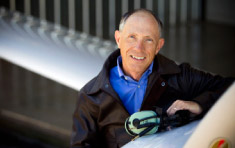 Aircraft that fly without a pilot on board have been called a variety of names—some of them unprintable. Drones, unmanned aerial systems (UAS), and unmanned aerial vehicles (UAV) are a few. Some pilots are concerned about bringing these machines into domestic airspace in a big way. The FAA is charged with figuring out how to get everyone to play in the sandbox safely.
Aircraft that fly without a pilot on board have been called a variety of names—some of them unprintable. Drones, unmanned aerial systems (UAS), and unmanned aerial vehicles (UAV) are a few. Some pilots are concerned about bringing these machines into domestic airspace in a big way. The FAA is charged with figuring out how to get everyone to play in the sandbox safely.
Military UAS has been a dominant player in the past decade, performing surveillance and strike operations in Iraq and Afghanistan. There have been a few military incidents, but not many that have been reported to the general press. As the capabilities have expanded, however, so has the civilian demand for what UAS can do—often at a fraction of the cost of manned aircraft.
As with any good idea, there are those who fail to behave responsibly, and so it is with UAS. The highest-profile incident involved a close call with a regional jet in Tallahassee, Florida, in March. The close encounter occurred at about 2,300 feet, five miles from the airport, and the UAS came close enough that the RJ was inspected for damage after landing; there was none. But the UAS pilot and aircraft were nowhere to be found. Birds can bring down aircraft and so can a small UAS.
In May, another UAS, known as a quadcopter, escaped from its owner and crashed into the thirtieth floor of a St. Louis office building. This time the aircraft did not get away unscathed, but the owner opted for anonymity by leaving some $2,000 in aircraft and camera gear unclaimed.
There have been numerous other mishaps—some amusing, others not so much—that punctuate the news, but the reality is that UAS hold tremendous potential for both good and ill. The challenge is to find the balance.
Depending on your perspective, the ability for police to use them in tactical situations, as the military has, is a reasonable use in my opinion. Search and rescue, disaster reconnaissance, real estate agents, legitimate journalists, the paparazzi, farmers, delivery services, and voyeurs all have interest. The FAA should not be charged with deciding the privacy issues. That’s the role of the courts and the legislative branch, and it can be messy, but the FAA’s role is operational safety—period.
The model aircraft community is understandably concerned, as is the Association for Unmanned Vehicle Systems International (www.auvsi.org), which represents all UAS from the smallest hummingbird to 737-sized behemoths.
In 1981 the FAA issued Advisory Circular 91-57 for model aircraft. It’s a good starting point for UAS regulation, but these voluntary guidelines are not sufficient for UAS—especially since the vehicles are no longer used merely for entertainment and recreation. The AC states, Select an operating site that is of sufficient distance from populated areas. The selected site should be away from noise sensitive areas such as parks, schools, hospitals, churches, et cetera. Do not operate model aircraft in the presence of spectators until the aircraft is successfully flight tested and proven airworthy. Do not fly model aircraft higher than 400 feet above the surface. When flying aircraft within 3 miles of an airport, notify the airport operator, or when an air traffic facility is located at the airport, notify the control tower, or flight service station. Give right of way to, and avoid flying in the proximity of, full-scale aircraft. Use observers to help if possible.
When UAS fly far away from people, either on the ground or aloft, perhaps the regs can be more forgiving—just as we allow for new Experimental aircraft in less dense airspace. They need to sense and avoid other aircraft. However, clear guidance is needed whenever a device slips the surly bonds of its handler and tears off like an errant Labrador Retriever. Collisions with people and other aircraft are unacceptable, and many small UAS operators don’t have the financial resources to cover liability costs should the unthinkable occur.
Temporary flight restrictions are not a solution for routine operations, either. AOPA says, “unmanned aircraft and their operation should be certified to the same level of safety as piloted aircraft. Their operation in the National Airspace System should not have a negative impact on GA operations and should not require specially designated airspace for their operation.”
The FAA, anticipating these aircraft in our airspace, convened a working group in 2007 to study the problem and make recommendations. It’s a work in progress, and many agree that it’s way past time for some basic rules to be published—even if they are not all-encompassing and subject to revision as the technology changes. UAS pose a number of problems, but they also open up some great opportunities for GA, including better utilization of airports, economies of scale in developing equipment to put on manned aircraft, and a source of new pilots—but, as always, safety comes first.
Bruce Landsberg has served as the president of the AOPA Foundation since January 2010.



